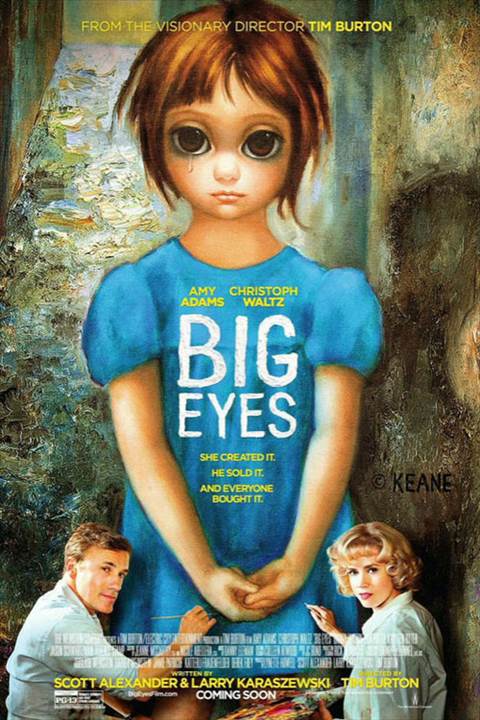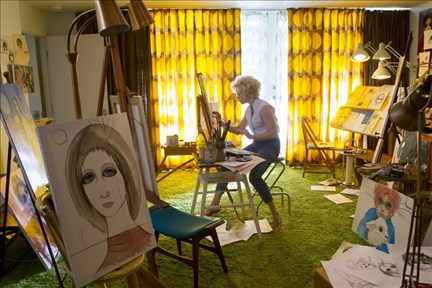“Big Eyes” is probably the least Tim Burton-y “Tim Burton movie” ever, a real life drama about fraud in the art world in the 1950s and 1960s, specifically, the story of the Keanes and the dispute over who created the series of Big Eye paintings.
Margaret (Amy Adams) got herself out of a bad marriage during a time when such a thing was not common at all, and she ended up in San Francisco, where she met Walter Keane (Christoph Waltz), a charming painter who took a liking to her and her paintings of small sad or scared children with big eyes. They fall in love, get married, and Walter tries to sell his schmaltzy paintings of French side streets along with his wife’s big eye painting, and only the big eyes get any traction. In giving Walter something of a benefit of doubt, this movie show Walter going along with a simple misunderstanding and then later feeling remorse for it openly, so it is not like he is some insane plagiarist monster from the get go. But that is what he becomes.
This movie is mostly devoid of that Tim Burton weirdness. There is a touch of “Edward Scissorhands” in the depiction of Americana and suburbia and a little “Ed Wood” which can’t be avoid because it is another biopic written by the same people, but otherwise this could have been made by any old journeymen director. There is some extra lushness in the production design and in the way some of the shots are composed, but that’s about it. And that is not really a good or bad thing, it is just an observation. Could this movie have benefited from a little more Burton extravagance? Maybe it could have. Or maybe it was better to just let this wild story stand on its own, which is more or less the approach taken here.
Because it IS a crazy story, and while much of it was written with the assistance of Margaret, one still has wonder how accurate this story is and what was changed for dramatic effect. This is a movie, after all. So did all the characters portrayed in this film even exist? Or are they amalgamations of different people, squished together into one caricature? Did all of the events actually happen in real life as portrayed in this movie? Probably not. Some instances were probably invented for thematic purposes. But it is hard to tell what is real and what is not and as such it all stands together pretty well as one cohesive story. I am sure if Walter Keane were still alive he’d have a thing or two to say about this movie, but he’s dead, so he doesn’t.
And as Walter Keane, Christoph Waltz is pretty damn good. He has the innate charm and verbosity that is required to show how someone like Walter could be the ultimate salesman as well as the ultimate crook. He dominates every scene he is in, imposing his well and his presence on everyone else around him, especially his wife Margaret, whom he manages to manipulate and con into joining him for his fraud, much to the detriment of her personal well being. And this is where Amy Adams comes in, because due to the nature of their relationship, Margaret is often left in the background and in the shadows while Walter spins his magic, so Amy Adams has a lot of work to do in conveying Margaret’s sense of loss at losing ownership of her art or her desperation to provide for her daughter or even the deteriorating relationship she has with her daughter as she continues to lie to her about Walter creating the artwork. So suffice to say, both Adams and Waltz are both quite good in this movie and really make this whole thing work.
“Big Eyes” is indeed a good movie and with good performances but it doesn’t really seem to stick with you. It has a few things to say about being a woman in 1950s and 1960s America and how it was a great time in America to be a man, but really the only things being said about that are “that was a shitty time for women” and “look at Margaret persevere through all the bullshit of those days.” So it is not like this movie is some grand feminist statement. And maybe it was never trying to be. But then what is “Big Eyes” if not just a simple telling of a somewhat crazy story? I guess art ownership and the old debate of “what is art?” is pretty important to this story, though the movie doesn’t really come down on either side of the argument, does it? There is a big New York Times art critic (Terence Stamp) who shits all over the Big Eyes art pieces, calling them all hack work and declaring them not to be art, and the only person who stands up to him and his stuffy ways is Walter Keane, so not exactly the movie’s number one bastion for honestness and integrity. And some people in this movie make that point that if so many people buy into it, it must be art, right? How can millions of people be wrong? But the truth is, millions of people are wrong all the time. This happens on a daily basis. So just because everyone likes these paintings, does it really make it art? Valuable art? Or just kitschy art? What is the answer? You will have to come up with it yourself, since “Big Eyes” offers no answers to this point, nor makes a stance.
But will it at least get the conversation started about such things? Surely. It is absolutely a fascinating story that encompasses some interesting topics and the movie is made well enough so in the end I guess I would call “Big Eyes” a success.



 CCN – November 2014
CCN – November 2014 #444 – Front Toward Enemy
#444 – Front Toward Enemy #557 – Pressure Related Deaths
#557 – Pressure Related Deaths Review: ‘After Earth’
Review: ‘After Earth’
Leave a Reply
You must be logged in to post a comment.